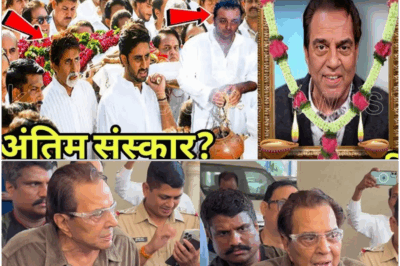Baba Bageshwar in danger of going to jail? Women crying in the ambulance and a conspiracy of silence.
.
.
.
Baba Bageshwar Dham Ambulance Controversy: Faith, Fear, and the Silence That Shook India
Introduction
In a country where faith is often considered beyond question, a recent incident at the renowned Bageshwar Dham has shaken public confidence and sparked a national debate. The viral video of women crying in an ambulance, allegedly being forcibly removed from the Dham premises, has raised uncomfortable questions about the intersection of religious power, women’s rights, and accountability. Is Bageshwar Dham only a place of miracles, or is there a darker side that has remained hidden from public view? As the controversy unfolds, the silence of Baba Bageshwar himself has become as much a subject of scrutiny as the incident itself.

The Incident: A Night of Fear
It was around 9 PM in Chhatarpur district, Madhya Pradesh, when a distress call was made to the local police. The caller reported a suspicious ambulance transporting several women under mysterious circumstances. Acting swiftly, the police intercepted the ambulance near Pattha Chowki. What they found inside stunned everyone present: thirteen women, visibly terrified, weeping and pleading for help. Their repeated cries of “Save us! We are being taken away by force!” echoed through the night, captured on video and soon to become the center of a storm.
The women claimed they had been forcibly picked up, threatened with violence if they resisted, and had no idea where they were being taken. The ambulance, it turned out, belonged to the Bageshwar Dham committee—a religious institution revered by millions for its supposed miracles and spiritual guidance. The question on everyone’s mind was immediate and urgent: Why was a religious ambulance, meant for the sick, carrying frightened women in the dead of night?
Who Are the Women? Victims or Accused?
As the police began their inquiry, the women revealed they had been living at Bageshwar Dham for months. Some said they had fled abusive households and found refuge in the Dham, where they felt safe and at peace. Now, they were being expelled—dragged out by their hair, according to some accounts, and loaded into an ambulance against their will.
When asked why they were being removed, a committee representative claimed the women were involved in theft and chain-snatching, and had overstayed under the pretense of attending court hearings. With the head priest, Baba Bageshwar, reportedly abroad, the committee decided to send them home. But this explanation only deepened the mystery. If the women were criminals, why was there no police complaint, FIR, or legal action? Why were they being transported at night, without any due process, and in a manner that left them traumatized?
The Role of the Dham: Shelter or Detention?
Bageshwar Dham is one of India’s most prominent religious sites, attracting thousands of devotees daily. For many, it is a place of miracles, hope, and transformation. But as the story of the ambulance spread, people began to question what really happens behind the scenes. Is faith being used as a cover for questionable practices? Are vulnerable women being protected, or exploited?
Some of the women told police that they had come to the Dham to escape violence at home and had grown attached to the community there. They wanted to stay, but were being forced out, allegedly without explanation or proper arrangements. The committee’s defense—that the women were disruptive or involved in petty crimes—was not backed by any evidence or legal procedure. This lack of transparency only fueled suspicion.
The Police Response and Legal Questions
The police detained two committee workers, including a woman named Mini, whom several women accused of threats and coercion. The ambulance driver admitted he was simply following orders from the committee. As the investigation proceeded, it became clear that there was no legal basis for the women’s removal. There were no outstanding warrants, no court orders, and no police complaints against them.

This led to larger questions: Does a religious institution have the right to decide who can stay or leave, especially when it functions as an informal shelter for distressed individuals? Shouldn’t there be oversight, registration, and legal protocols for people living within such establishments for extended periods? The lack of answers pointed to systemic gaps in how religious trusts operate, often beyond the reach of regulatory scrutiny.
The Silence of Baba Bageshwar
As the controversy exploded across social media and news channels, one voice was conspicuously absent: that of Baba Bageshwar himself. His silence became a focal point of public anger and speculation. Supporters claimed he was abroad and unable to comment, but critics pointed out that in today’s digital age, a statement or clarification could be made from anywhere in the world. Why was there no response—no video call, no press note, no social media post?
The silence was interpreted by many as indifference or, worse, complicity. If Baba Bageshwar is the spiritual leader of a movement that commands the devotion of millions and receives vast sums in donations, does he not owe the public an explanation in the face of such serious allegations? The lack of accountability has damaged not just his personal credibility, but also the reputation of the institution he leads.
Faith vs. Accountability: The National Debate
The incident has divided public opinion sharply. Some see it as a conspiracy to defame Bageshwar Dham and its leader, arguing that such stories are often manufactured to target popular religious figures. Others, however, insist that faith cannot be used as a shield against questions of legality, morality, and basic human rights.
Social media has been flooded with debates: Should religious institutions be held to the same standards of transparency and accountability as any other organization? Are women’s voices being silenced in the name of faith? Is it acceptable to ignore cries for help simply because they come from within the walls of a revered religious site?
The Broader Context: Women, Power, and Silence
The Bageshwar Dham controversy is not an isolated case. Across India, there have been numerous instances where women seeking refuge in religious or charitable institutions have faced mistreatment, exploitation, or forced removal. The lack of proper oversight, combined with the aura of sanctity surrounding such places, often allows abuse to go unchecked.
What makes this case different is the visibility provided by the viral video. The cries of the women, their visible fear, and the absence of any legal justification for their removal have struck a chord with the public. Activists, women’s rights organizations, and even government bodies have begun to demand answers. The National Commission for Women and various human rights groups have called for a thorough investigation and for the rights of the women involved to be protected.
The Conspiracy of Silence
One of the most disturbing aspects of the incident is the “conspiracy of silence” that seems to surround it. Despite the outcry, official responses have been evasive. The committee’s explanations have been inconsistent, and the police investigation appears to be losing momentum. The media, after an initial burst of coverage, has also begun to move on.
This silence is emblematic of a larger problem: the tendency to overlook or suppress uncomfortable truths when they challenge powerful interests or cherished beliefs. Whether out of fear, reverence, or apathy, too often society chooses not to confront the darker realities lurking behind the facade of faith.
Conclusion: The Lessons of Bageshwar Dham
The Bageshwar Dham ambulance controversy has exposed the fault lines between faith and accountability in India. It has shown how easily the vulnerable can be silenced, how powerful institutions can evade scrutiny, and how public outrage can be both intense and fleeting.
The real question is not whether miracles happen at Bageshwar Dham, but whether the institution and its leaders are willing to be transparent and answerable to the people they serve. Until that happens—until the cries of women in distress are met with justice rather than silence—the credibility of all such institutions remains in doubt.
As the dust settles, one thing is clear: faith is not a license to abuse power, and silence is not a substitute for justice. The women in the ambulance, their fear and their voices, have forced the nation to confront uncomfortable questions. It is up to Baba Bageshwar, his committee, and indeed all of us, to ensure that the answers are not buried in the darkness of denial.
play video:
News
Bharti Singh burnt Labubu doll for her son Gola due to superstitious incidents! Labubu doll
Bharti Singh burnt Labubu doll for her son Gola due to superstitious incidents! Labubu doll . . . The Rise,…
How did Preeti Jhangiani, the heroine of the movie Mohabbatein, disappear? Dharmendra’s movie
How did Preeti Jhangiani, the heroine of the movie Mohabbatein, disappear? Dharmendra’s movie. . . . The Rise, Disappearance, and…
🔴Where will Dharmendra’s last rites be held? Information has come out? Dharmendra Deol death news viral?
🔴Where will Dharmendra’s last rites be held? Information has come out? Dharmendra Deol death news viral? . . . Dharmendra…
Kareena Kapoor ran away after robbing Saif Ali Khan. Saif Ali Khan! Kareena Kapoor
Kareena Kapoor ran away after robbing Saif Ali Khan. Saif Ali Khan! Kareena Kapoor. . . . Kareena Kapoor and…
Urfi Javed Face Condition Getting Worse Day By Day In Hospital
Urfi Javed Face Condition Getting Worse Day By Day In Hospital . . . Urfi Javed’s Worsening Face Condition: Hospitalization,…
🔴 Dharmendra’s last picture came out before his death? Did fans cry after watching the funeral? dharmender Deol
🔴 Dharmendra’s last picture came out before his death? Did fans cry after watching the funeral? dharmender Deol . ….
End of content
No more pages to load










